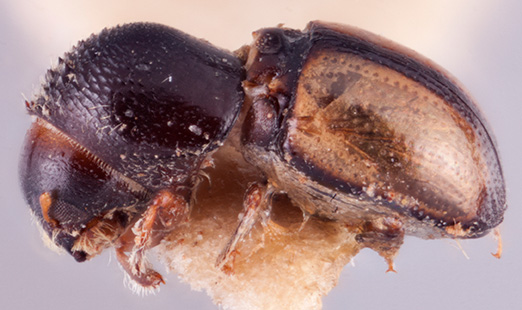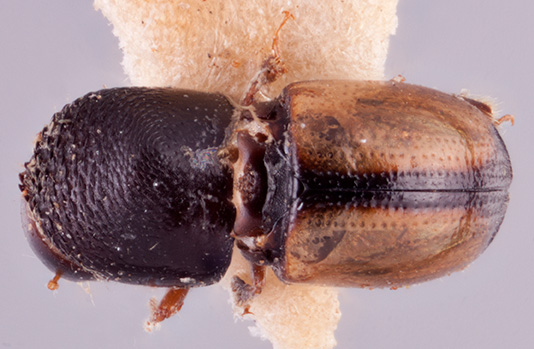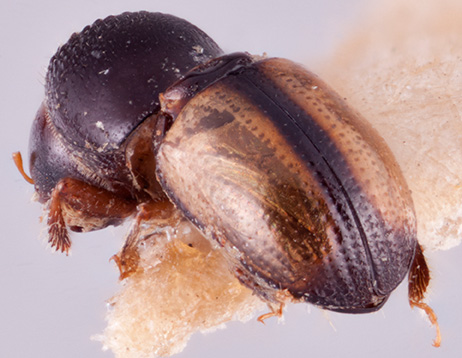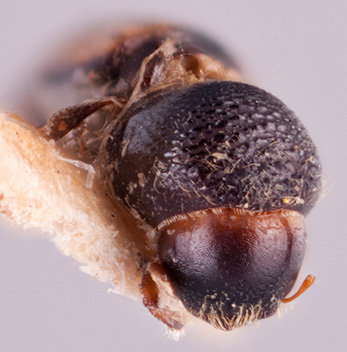Cnestus suturalis
|
Cnestus suturalis cotype lateral; R.K. Osborn |
|
Cnestus suturalis cotype dorsal; R.K. Osborn |
|
Cnestus suturalis cotype declivity; R.K. Osborn |
|
Cnestus suturalis cotype frontal; R.K. Osborn |
Taxonomic history
Xyleborus suturalis Eggers, 1930: 200.
Cnestus suturalis (Eggers): Wood and Bright, 1992: 803.
Diagnosis
2.8 mm long (mean = 2.8 mm; n = 2); 2.55 times as long as wide. This species can be distinguished by the presence of a mesonotal mycangial tuftmycangial tuft:
tuft of setae that denotes the mycangia exterior opening
 on the pronotalpronotal:
on the pronotalpronotal:
pertaining to the pronotum
basebase:
point or edge closest to the body; opposite of apex , rounded elytralelytral:
, rounded elytralelytral:
pertaining to the elytra
declivitydeclivity:
downward slope of either the pronotum or elytra
 , elytraelytron:
, elytraelytron:
the two sclerotized forewings of beetles that protect and cover the flight wings
often with a transparent area, pronotumpronotum:
the dorsal surface of the thorax
from dorsaldorsal:
of or relating to the upper surface; opposite of ventral
 view type 1, antennalantennal:
view type 1, antennalantennal:
pertaining to the antennae
club type 1, with no sutures visible on the posteriorposterior:
toward the rear end; opposite of anterior
 face, three segmented antennalantennal:
face, three segmented antennalantennal:
pertaining to the antennae
funicle, protibiaprotibia:
tibia of the first pair of legs
obliquely triangular, declivitaldeclivital:
pertaining to the elytral declivity
striae with punctures much coarser, deeper than those of discdisc:
the flat central upper surface of any body part (e.g. pronotum and elytra) , interstriaeinterstria:
, interstriaeinterstria:
longitudinal spaces along the elytra between the striae, which is not as<br />
impressed and bear smaller punctures.
 2 and 3 strongly narrowed toward apexapex:
2 and 3 strongly narrowed toward apexapex:
point or edge furthest from the body; opposite of base
 , striaestria:
, striaestria:
punctures in rows, which may or may not be impressed to make grooves 1−3 impressedimpressed:
1−3 impressedimpressed:
a depression in a surface
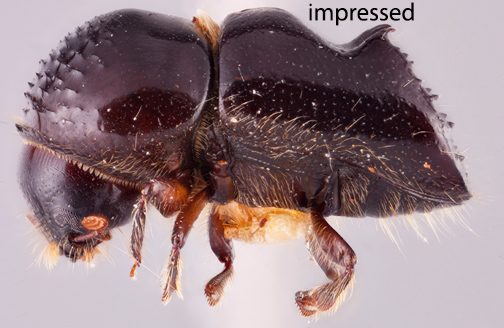 .
.
This species strongly resembles Cnestus aterrimus which has declivitial strial punctures similarly sized to those of discdisc:
the flat central upper surface of any body part (e.g. pronotum and elytra) , interstriaeinterstria:
, interstriaeinterstria:
longitudinal spaces along the elytra between the striae, which is not as<br />
impressed and bear smaller punctures.
 2 and 3 not narrowed toward apexapex:
2 and 3 not narrowed toward apexapex:
point or edge furthest from the body; opposite of base
 , and at most striaestria:
, and at most striaestria:
punctures in rows, which may or may not be impressed to make grooves 1 and 2 impressedimpressed:
1 and 2 impressedimpressed:
a depression in a surface
 .
.
May be confused with
Distribution
China (Guizhou, Yunnan), India (Andaman Is, Meghalaya), Indonesia (Java), Vietnam
Host plants
recorded from Eupatorium (Asteraceae), Terminalia (Combretaceae), Swietenia (Meliaceae) and Piper (Piperaceae), and presumed polyphagous (Beeson 1961Beeson 1961:
Beeson CFC. 1961. The ecology and control of the forest insects of India and the neighbouring countries. 2nd edition. Government of India, New Delhi, 767 pp., Kalshoven 1959bKalshoven 1959b:
Kalshoven LGE. 1959b. Studies on the biology of Indonesian Scolytoidea 4. Data on the habits of Scolytidae. Second part. Tijdschrift voor Entomologie 102: 135-173 + pls. 15-22.)
DNA data
Sequences available for COI and CAD.
COI: MN619879
CAD: MN620161

